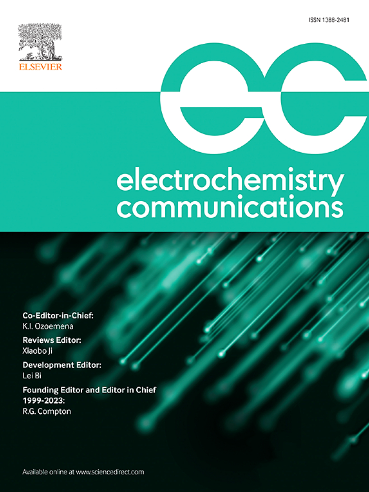三组分NiO/La2O3/MWCNTs催化剂上醇电氧化DAFC的应用
IF 4.2
3区 工程技术
Q2 ELECTROCHEMISTRY
引用次数: 0
摘要
酒精电氧化是直接酒精燃料电池(DAFCs)中的一个关键反应,它有效地将甲醇和乙醇等酒精转化为电能,同时对环境的影响最小,为化石燃料提供了一种可持续的替代品。这一过程对可再生能源技术、促进清洁能源解决方案至关重要。该领域的研究考虑了电催化剂的发展,改善反应动力学,降低燃料电池的成本。由于催化剂基金属氧化物的广泛应用,我们采用水热法合成了一种三组分催化剂,包括氧化镍(NiO)/氧化镧(La2O3)催化剂及其与碳纳米管(MWCNT)的杂化。考察了催化剂在醇氧化反应(AOR)中的性能。证实了NiO/La2O3和NiO/La2O3/MWCNTs催化剂的成功合成。研究了在NiO/La2O3双金属氧化物结构中加入碳纳米管对甲醇乙醇氧化反应(MOR和EOR)的影响。在NiO/La2O3/MWCNTs催化剂的MOR和EOR中,在0.66和0.62 V电位下获得的最大电流密度分别为110.71和43.56 mA/cm2,作为直接醇燃料电池(DAFC)催化剂具有较好的效率。此外,通过比较NiO/La2O3和NiO/La2O3/MWCNTs催化剂在MOR和EOR过程中的Tofel斜率,发现含碳纳米管催化剂在MOR和EOR过程中的动力学更快。因此,良好的性能和高稳定性为进一步的操作研究提供了良好的前景。本文章由计算机程序翻译,如有差异,请以英文原文为准。
Alcohol electrooxidation on three-component NiO/La2O3/MWCNTs catalyst for DAFC application
Alcohol electrooxidation is a crucial reaction in direct alcohol fuel cells (DAFCs), efficiently converting alcohols like methanol and ethanol into electricity with minimal environmental impact, offering a sustainable alternative to fossil fuels. This process is vital for renewable energy technologies, promoting clean energy solutions. Research in this field considers electrocatalyst development, improving reaction kinetics, and reducing fuel cell costs. The wide application of catalyst-based metal oxides led us to synthesize a three-component catalyst, including nickel oxide (NiO)/lanthanum oxide (La2O3) catalyst and its hybrid with carbon nanotubes (MWCNT), with the hydrothermal method. The capability of catalysts was investigated in alcohol oxidation reactions (AOR). The successful synthesis of NiO/La2O3 and NiO/La2O3/MWCNTs catalysts was confirmed. The effect of adding carbon nanotubes to the NiO/La2O3 double metal oxide structure on the methanol and ethanol oxidation reaction (MOR and EOR) was investigated. In MOR and EOR by NiO/La2O3/MWCNTs catalyst, the maximum current densities of 110.71 and 43.56 mA/cm2 were obtained at potentials of 0.66 and 0.62 V, respectively, representing relatively good efficiency as a direct alcohol fuel cell (DAFC) catalyst. Also, the comparison of the Tofel slope of NiO/ La2O3 and NiO/La2O3/MWCNTs catalysts in MOR and EOR processes shows the faster kinetics of the catalyst containing carbon nanotubes in these processes. So, good performance and high stability of catalysts can be promising for further operational investigations.
求助全文
通过发布文献求助,成功后即可免费获取论文全文。
去求助
来源期刊

Electrochemistry Communications
工程技术-电化学
CiteScore
8.50
自引率
3.70%
发文量
160
审稿时长
1.2 months
期刊介绍:
Electrochemistry Communications is an open access journal providing fast dissemination of short communications, full communications and mini reviews covering the whole field of electrochemistry which merit urgent publication. Short communications are limited to a maximum of 20,000 characters (including spaces) while full communications and mini reviews are limited to 25,000 characters (including spaces). Supplementary information is permitted for full communications and mini reviews but not for short communications. We aim to be the fastest journal in electrochemistry for these types of papers.
 求助内容:
求助内容: 应助结果提醒方式:
应助结果提醒方式:


